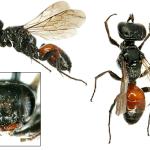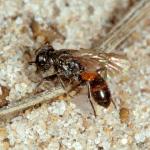A revised key to the now three British species of Miscophus has been published by Knowles and Else (2005). Dark specimens of male M. concolor are not always readily separated from male M. ater on gaster colour alone, but the closeness of the punctation on the frons seems to be a reliable, if subtle, character for which comparative material is useful.
Richards (1980) records a slightly disjunct distribution in the south from Dorset, east to Surrey and east Kent, plus Berkshire, Bedfordshire and Nottinghamshire. Records received as part of this Atlas project include Devon and Gloucestershire (M E Archer, pers. comm.), plus two localities in East Anglia; but the majority remain from southern counties. Hampshire, Surrey and West Sussex heaths are its main stronghold. Lomholdt (1984) states that it occurs in Denmark, Sweden and Finland and is scattered in Europe, without much further detail. Bitsch et al. (2001) show that it occurs very sparingly across France and gives its distribution as central and northern Europe, adding Poland, Russia, Spain and parts of Italy.
This species is not regarded as being scarce or threatened.
This small wasp occurs in warm, open sandy habitats at both coastal and inland localities.
Richards (1980) gives June to September, but the majority of available records come from July and August.
Small spiders are listed as prey items (Lomholdt 1984). Bitsch et al. (2001) give references to very small Lycosid and Salticid spiders.
Relatively little seems to be known about the nesting biology of this species. Nests are excavated in sandy ground and comprise tubes a few centimetres long (Lomholdt 1984).
No data available.
No data available.



